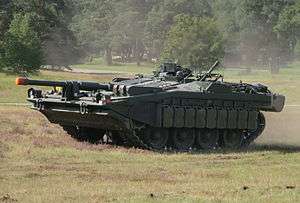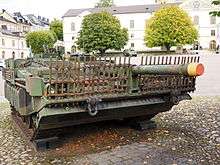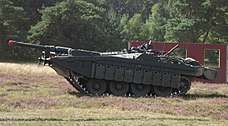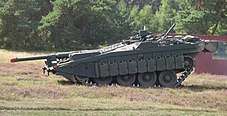Stridsvagn 103
The Stridsvagn 103 (Strv 103), [Note 1] also known as the S-Tank,[Note 2] is a Swedish post-World War II main battle tank, designed and manufactured in Sweden.[3] It was developed in the 1950s and was the first main battle tank to use a turbine engine and the only mass-produced tank since World War II to dispense with a turret.[4] It has an unconventional design with a unique gun laying process:[5][6][7] it is turretless with a fixed gun traversed by engaging the tracks (like the 75mm gun on the 1930s French Char B1) and elevated by adjusting the hull suspension.[4] The result was a very low-profile design with an emphasis on survivability and heightened crew protection level. Strv 103s formed a major portion of the Swedish armoured forces from the 1960s to the 1990s, when, along with the Centurions, it was replaced by the Leopard 2 variants Stridsvagn 121 and Stridsvagn 122.[8] While most turretless armoured fighting vehicles are classified as assault guns or tank destroyers, the Strv 103 is considered a tank since its designated combat role matched those of other tanks within contemporary Swedish doctrine.
| Stridsvagn 103 | |
|---|---|
 A Stridsvagn 103C at the Swedish Army's Revingehed training ground, August 2013 | |
| Type | Amphibious main battle tank |
| Place of origin | Sweden |
| Service history | |
| In service | 1967–1997 |
| Used by | Swedish Army |
| Production history | |
| Designer | Sven Berge |
| Designed | 1956 |
| Manufacturer | Bofors AB |
| Produced | 1967–1971 |
| No. built | 290 |
| Variants | A, B, C, D |
| Specifications | |
| Mass | 103 B: 39.7 t (43.8 short tons; 39.1 long tons) 103 C: 42.5 t (46.8 short tons; 41.8 long tons) |
| Length | 9 m (29 ft 6 in) (incl. gun) |
| Width | 103 B: 3.60 m (11 ft 10 in) 103 C: 3.80 m (12 ft 6 in) |
| Height | Including topmounted MG: 2,430 mm (8 ft 0 in) To cupola: 2,140 mm (7 ft 0 in) To vehicle roof: 1,900 mm (6 ft 3 in) To barrel centre when horizontal: 1,700 mm (5 ft 7 in) |
| Crew | 3 (Commander, gunner/driver, rear driver)[1] |
| Armor | LOS: ≈192–337mm Actual: 40–70mm |
Main armament | Bofors L74 10.5 cm L/62 rifled gun with Autoloader and 50 rounds |
Secondary armament | two fixed 7.62 mm KSP 58 machine guns one anti-aircraft 7.62 mm KSP 58 machine gun two 71mm Lyran mortars |
| Engine | 103 A: Rolls-Royce K60 diesel, 240 hp (179 kW) and Boeing GT502 gas turbine, 300 hp (223 kW) 103 B: Rolls-Royce K60 diesel, 240 hp (179 kW) and Caterpillar 553 gas turbine, 490 hp (365 kW) |
| Power/weight | 18.3 hp/tonne (C version) |
| Transmission | 2 forward and 2 reverse speeds |
| Suspension | Gas-hydraulic hydropneumatic suspension |
Operational range | 390 km (240 mi) |
| Maximum speed | 60 km/h (37 mph) maximum road speed forwards or reverse[2] |
History
[9] In the mid-1950s, the Royal Swedish Army Material Administration (Kungliga Arméförvaltningens Tygavdelning) put out a contract tender for next generation tank design to replace their Centurions. A consortium of Landsverk, Volvo and Bofors responded with a suggestion to revive an earlier domestic heavy tank design, known under the codename KRV, fitted with a 155 mm smoothbore gun in an oscillating turret. However, this was deemed too expensive in comparison to the alternatives: A (Anglo-American), which was to purchase a 50-ton tank with high protection and mediocre mobility from either the UK or US. Alternative T (Tysk-Fransk /German-French) was a 30-ton tank with low protection and good mobility. Then, in 1956, Sven Berge of the Swedish Arms Administration proposed Alternativ S, a domestic alternative (S standing for Swedish).
Development
Studies of casualty reports from World War II and the Korean War revealed that the risk of being hit in combat was strongly related to height, with more than half of tank losses being the result of the turret being penetrated. Berge therefore concluded that any new design should be as low as possible. The radical solution was to eliminate the turret, which would also dispose of a vulnerable target area and make the tank much lighter. In terms of absolute height, the final design (see below) did not give the Strv 103 any significant advantage over its most likely opponent, the T-62. The latter was just sightly taller with 2.20 m (7 ft 3 in) in height with its turret versus the 2.14 m (7 ft 0 in) of the Strv 103. On the other hand, the Swedish Centurions towered over both with their 2.94 m (9 ft 8 in) – 3.01 m (9 ft 11 in) in height. However, the T-62 paid for its low profile with an extremely cramped interior and lack of gun depression. Tanks are often deployed in hull-down firing positions, either behind dug entrenchments or using the crest of a hill, in order to reduce the exposure of the vehicle to enemy fire. In this firing position, the level of exposure is determined by the distance between the bottom of the gun barrel and the top of the turret or vehicle, and the angle to which the vehicle is able to depress the gun barrel. Since the Strv 103 orients the entire tank to depress and elevate the barrel, in a hull down position it has very little apparent height and subsequent visual profile to the enemy. It could also lower the hull a further 13 centimetres (5.1 in) by adjusting the suspension.
Familiar with both the French Char B's precision transmission, the exceptional turning performance of the short tracked assault guns and the combat performance of the German StuG and Jagdpanzer series inspired Berge's design to solve the aiming problem through the use of a fully automated transmission and suspension system, which precisely turned and tilted the tank under the gunner's control. The gun itself would be fixed to the hull.[9] This made it impossible to use a stabilised gun. As a result, the tank could not accurately move and fire at the same time, but the Swedish experience with Centurions suggested that, in order for tanks to reach acceptable accuracy, they would need to come to a halt anyway, and wrongly estimated that no breakthrough in stabilisation technology was likely within the foreseeable future.
Other features of the tank were also quite radical. The rifled gun, a Bofors 105 mm L74 with a barrel length of 62 calibres, was able to use the same ammunition as the British Royal Ordnance L7, and would be equipped with an autoloader allowing a rate of fire of one round every third second, also allowing the crew to be reduced to two; a gunner/driver and the commander (most designs of the era used a crew of four), with a single person being able to handle all functions of the tank from his ordinary position due to duplicate controls. This would of course only be used in emergencies, as the workload would be overwhelming, but apart from providing redundancy it also allowed the crew to shift tasks between them as situation required. The concept went through practical tests, that quickly revealed that a two-man crew would not be self-sufficient when considering the many tasks not directly related to handling the tank: in particular, routine maintenance, bivouacking, track-changes and reloading in field. While the last issue could have been solved by adding staff to the ammunition crews, it was decided that a third crew-member was needed. To enhance combat effectiveness, the third man was to be assigned as a rear driver/radio operator, facing the rear of the tank and equipped with a complete setup for driving. This allowed the tank to be driven backwards at the same speed as forwards, keeping its frontal armour pointed at the enemy, while relieving the commander of routine radio duty. The commander and gunner/driver both had the same set of sights and controls to fire the gun and drive the tank.
The tank was uniquely powered by two different kind of engines, a 240 horsepower (180 kW) Rolls-Royce K60 opposed-piston diesel for slow cruising and manoeuvring the tank in aiming, and a 300 horsepower (220 kW) Boeing 502 turbine for additional power when travelling at higher speed or in severe terrain; the same layout that later gave the naval configuration called CODAG (COmbined Diesel And Gas), even if many ships had instead the simpler CODOG (COmbined Diesel Or Gas) thanks to the difference between the diesel and turbine power (see, for example, many frigates built for the NATO navies, including the Maestrale and Bremen classes). The turbine was quickly found to be underpowered, and was replaced by a Caterpillar turbine delivering 490 horsepower (370 kW) after no more than 70 tanks had been produced, and retrofitted to all previous vehicles. This was the first use of a turbine engine in a production tank; the Soviet T-80 and US M1 Abrams would later be built with gas turbines for main propulsion. The concept was interesting enough that Bofors was asked to build a prototype of the suspension/drive train, which they completed successfully.
The Strv 103 was fully amphibious. A flotation screen could be erected around the upper hull in about 20 minutes, and the tracks would drive the tank at about 6 kilometres per hour (3.7 mph) in water.
One tank in each platoon was fitted with a dozer blade under the front hull, which was from outside the tank manually dropped and locked into working position with pins and support strutters. The blade allowed it to do simple engineering task, like digging fire pits for the platoon, filling trenches for ease of passage and so forth. Once the task was completed, the blade was again manually returned to the position under the front hull and locked in place. Upon the introduction of the 103C model all tanks had a bulldozer blade fitted, both to speed up operations and for the increased protection of the lower hull.
Service
In preparation for the defence plan of 1958 (Försvarsbeslut 1958 (FB58)) in the Riksdagen (Swedish parliament), the procurement set Alternativ S against the two foreign alternatives Alternativ A and Alternativ T. While the domestic alternative was going to be more expensive, the defence committee report recommended "S" when weighing in the symbolic value of a domestic tank for a neutral country as well as the spin-off effects on Swedish industrial competence.
Riksdagen made the formal decision regarding FB58 on 4 February 1958, and a follow-on contract called for two production prototypes, which were completed in 1961. By this point, the army was so satisfied with the design that an initial pre-production order for 10 was placed in 1960.
With minor changes, the Alternativ S was adopted as the Stridsvagn 103 ("103" from being the third tank with a 10 cm calibre gun accepted into Swedish service). Full production started in 1967 and ended in 1971 with 290 delivered. The changes included a new gyro-stabilised commander's cupola armed with a 7.62mm KSP 58 machine gun, and upgraded frontal armour. A unique grid could be mounted at the front to help defeat HEAT rounds; however, it was kept secret for many years and was to be fitted only in the event of war.
Despite its design the Strv 103 was intended for offensive operations. The armoured brigades of the Swedish army, which operated the Strv 103, were designated anfallsbrigader (assault brigades) and tasked with launching counter-offensives on enemy beachheads and airborne landings.[10][11] The stated Swedish armoured doctrine contemporary to the tank describes an aggressive approach to armoured warfare, even in defensive situations.[12] The design of the Strv 103, with its low profile, was based on protection rather than defensive battlefield behaviour.[10]
In 1980, the Swedish army requested all tanks in the inventory to be scrapped and replaced with Stridsvagn 2000. In 1982, the Riksdag decided for severe reduction of the military budget in Försvarsbeslutet 1982, and decided the tank-fleet should go through a REMO (Renovation and modification) to at least somewhat bring them up to standard while within the economic frames imposed.[13]
Performance
The Stridsvagn 103 never saw combat and so its design remains unproven. However, for its intended role in the 1960s, it had numerous advantages. In 1967, Norway carried out a two-week comparative observation test with the Leopard 1 and found that, with closed hatches, the 103 spotted more targets and fired faster than the Leopard while the situation was reversed when operating with hatches open. In April to September 1968, two 103s were tested at the British armour school in Bovington, which reported that "the turretless concept of the "S"-tank holds considerable advantage over turreted tanks". In 1973, the BAOR tested the 103. British crewmen received six weeks training and the vehicles were serviced by Swedish engineers. Over nine days of manoeuvres alongside the Chieftain tank, availability never fell under 90% and the final report stated, "It has not been possible to prove any disadvantage in the "S" inability to fire on the move."[14] In 1975, two 103s were tested at the American armour center at Fort Knox. The trial demonstrated that the 103 fired more accurately than the M60A1E3, but on an average 0.5 seconds more slowly.[15]
In comparison with the Centurion, the shorter track of strv 103 meant it performed worse on soft ground (mud and snow), the trench taking and vertical obstacle capabilities were also significantly lower: where the Centurion climbed a 100 cm wall, the 103 barely was able to climb an 80 cm wall. On hard terrain, the 103 on the other hand was far more manoeuvrable.[16]
Versions
Stridsvagn 103B

As the weight of the Strv 103 had increased compared to the pre-production tanks, the 103 turned out to be under-powered. Hence, a more powerful version of the same gas turbine, manufactured by Caterpillar, was introduced after the first production run of 80 tanks. The early version tanks (retroactively designated Strv 103A) were soon upgraded to B-standard. Adjustments to the hydro-pneumatic suspension increased elevation range from −10 through +12 degrees, to −11 through +16 degrees.[17]
Stridsvagn 103C
An upgrade programme was started in 1986 to fit all vehicles with improved fire control systems. Also, each Strv 103 was fitted with a dozer blade, rather than just one per platoon. A further upgrade in 1987/88 replaced the Rolls-Royce engine with a newer 290 horsepower (220 kW) Detroit Diesel with additional fuel cans placed along the sides to function as applique armour, and added a new laser rangefinder.
Stridsvagn 103D
In the mid-1990s, as the Swedish Armed Forces were looking for a new main battle tank, one Strv 103C was upgraded into the Strv 103D. The major changes were the installation of fire-control computer, thermal viewers for both the gunner and the commander, allowing the crew to fight at night-time and in bad weather conditions, and the installation of passive light enhancers for driving. Some minor changes to the suspension system and engine were also made.
There was some consideration of adding both reactive and/or appliqué armour in the early 1990s, but, in the end, the Strv 103 was instead phased out of Swedish service in favour of the Stridsvagn 122 (Strv 122), which entered service in 1997 (the last year that the Strv 103 was used to train tank crews).
This prototype was used during the trials for the new main battle tank system for the Swedish Armed Forces alongside all the other tanks tested. For a few years this prototype was even tested under remote control. The sole Strv 103D is today on display at the Axvall armor museum,[18] together with some 103C models. They are all still in running order.
Tanks on display
The following exhibitions possess an S-tank on display:
Sweden
- Försvarsmuseum Boden, Boden through Föreningen P5
- Försvarsfordonsmuseet Arsenalen, Härad, Sweden
Germany
Deutsches Panzermuseum Munster
UK
The Tank Museum, Bovington
Australia
RAAC tank museum
France
Musée des Blindés (Museum of Armored Vehicles), Saumur
See also
- FV4401 Contentious: air-portable tank destroyer with gun-elevation through hydraulic suspension.
- VT tank: German turret-less MBT-project.
Tanks of comparable role, performance and era
- AMX-30: French main battle tank
- Chieftain: British main battle tank
- Leopard 1: German main battle tank
- M60 Patton: American main battle tank
- T-62: Soviet main battle tank
- T-72: Soviet main battle tank
- TR-85: Romanian main battle tank
- Type 69/79: Chinese main battle tank
- Type 74: Japanese main battle tank
- Vijayanta: Indian main battle tank
Notes
References
- Bovington Tank Museum
- Berge, Sven (March–April 1973). "Engine Design and Placement". Armor. p. 17.
- Chant, C. & Jones, R. (2004). Tanks: Over 250 of the World's Tanks and Armoured Fighting Vehicles. Summertime Publishing. p. 156. ISBN 0-7603-1871-9. Retrieved 9 February 2011.
- Ogorkiewicz, Richard M (1991). Technology of tanks. ISBN 0710605951.
- "Stridsvagn 103 s tank clutch and break manoeuvre" – via YouTube.
- "Tekniskt Magasin – Stridsvagn 103" – via YouTube.
- "Trafikmagasinet provkör STRIDSVAGN S" – via YouTube.
- Strv 121 & strv122
- Lindström, Rickard O. (26 January 2012). "Historien bakom Strv 103 "S"" (in Swedish). Retrieved 8 December 2019.
Redan 1943 hade han läst i en tysk tidskrift om franska försök 1940 med en vagn som hade en grovkalibrig kanon lagrad i chassit vid sidan av föraren. Försöken, med utgångspunkt i stridsvagnen Char B, visade att riktning av vagnspjäsen i sidled kunde göras hydrostatiskt med hjälp av bandrörelser – överlagringsstyrning.
Sven kunde också dra sig till minnes vad det korta bandstället på stormkanonvagnarna medförde för sidriktmöjligheten. Han hade själv varit med och utvärderat den tyska surplusmaterielen som köptes in till Sverige efter kriget och blivit fascinerad av tyskarnas tornlösa vagnar av typ Sturmgeschütz eller Jagdpanzer – vagnar som togs fram snabbare och billigare än de vanliga tornstridsvagnarna utan att det gjordes avkall på vare sig eldkraft, rörlighet eller skydd. - Hugemark, Bo (2015). Den Stora Armén (in Swedish). Medströms Bokförlag. pp. 27–28, 128–33, 257–60. ISBN 978-91-7329-123-1.
- Hugemark, Bo; Björeman, Carl (2017). "Chapter 7, Milo S – fienden skulle hejdas vid kusten". Den Stora Invasionen (in Swedish). Medströms Bokförlag. pp. 131–63. ISBN 978-91-7329-138-5.
- "Pansarreglemente Stridsvagnspluton" (PDF) (in Swedish). 1974.
- Prop. 1981/82:102 Bilaga 2 Försvarsdepartementet p.14 Renovering och modifiering av stridsvagnar
- "Comparisons with turreted tanks". Home4.swipnet.se. 12 April 1998. Retrieved 27 September 2015.
- Luno (18 November 2004). "Foreign test off the S-Tank (picture and movie)". Archived from the original on 30 September 2007.CS1 maint: unfit url (link)
- https://www.youtube.com/watch?v=Aoe25OsTIng via YouTube
- In Detail Special No. 4 – Strv 103B / C S – Tank 103c at the Belgian Royal Army Museum & 1/35 and 1/72 Scale Models – Photo Manual for Modelers Paperback – 2007, page 5
- "Pansarmuseet". Pansarmuseet.se. Retrieved 31 July 2012.
Sources
- "Stridsvagn 103 S (E1995.105)". Bovington Tank Museum vehicle collection. tankmuseum.org. Retrieved 23 October 2010.
- Stridsvagn 103 S (E1995.105) at The Tank Museum
- Historien bakom Stridsvagn 103 "S" (in Swedish)
External links
| Wikimedia Commons has media related to Stridsvagn 103. |
- Society S-tank – Welcome to The S tank association – official site of the S tank association
- "Vapenverkan mot Stridsvagn 103" 20:28 minutes, English subtitles

